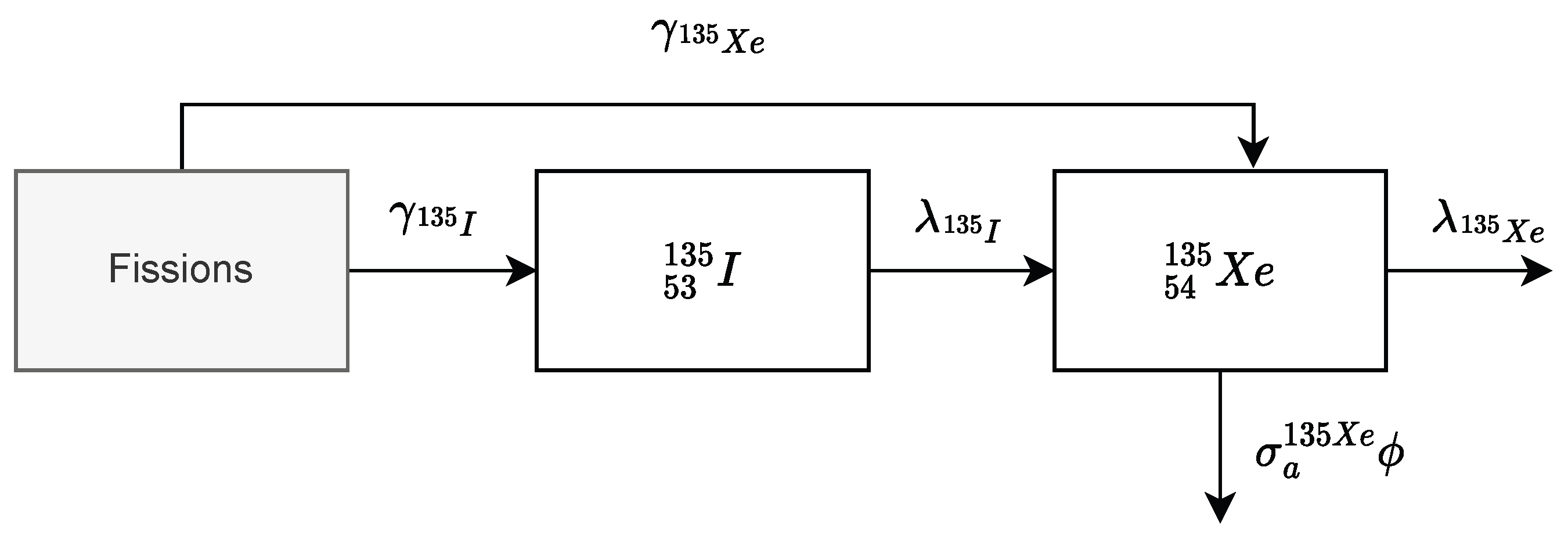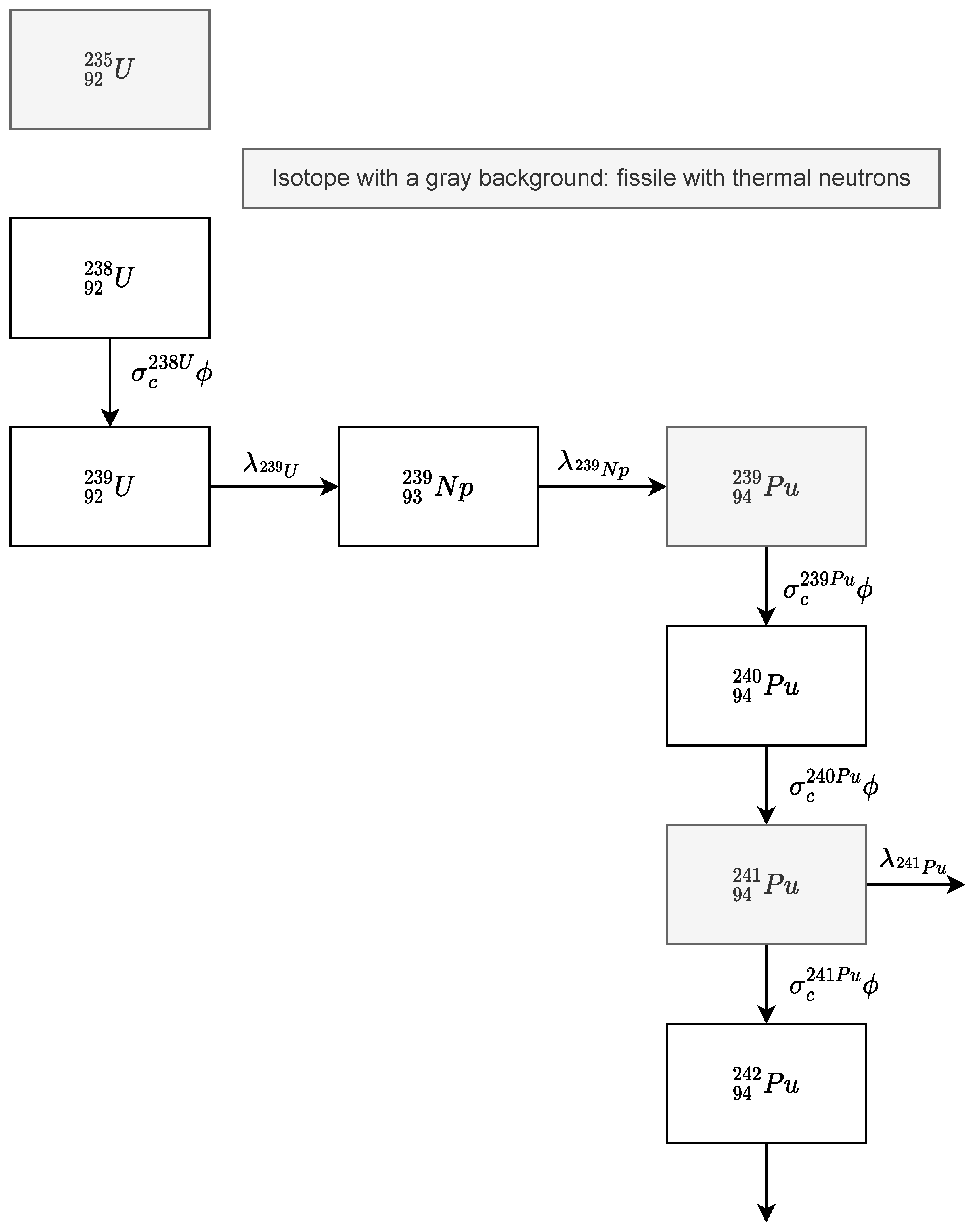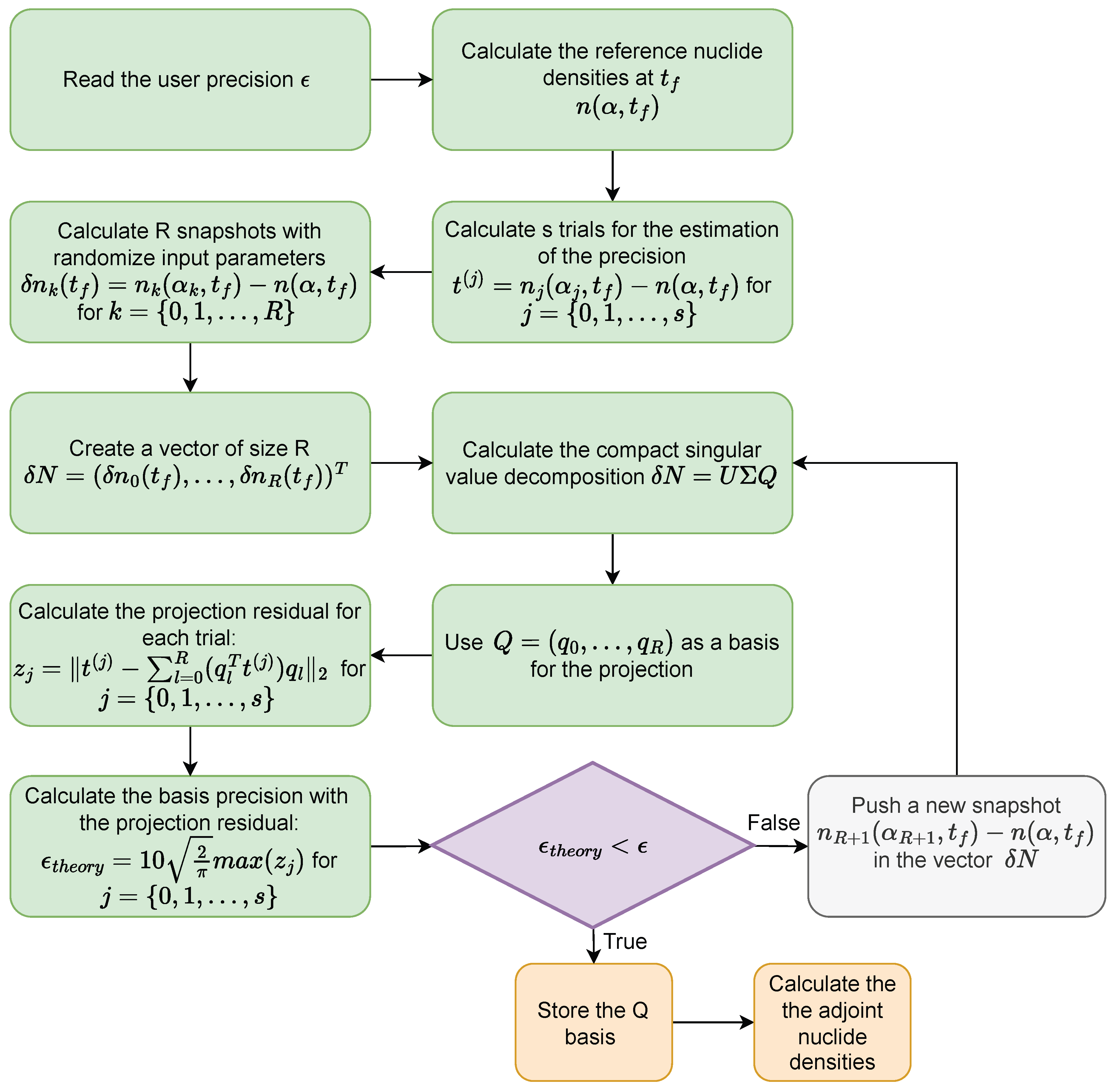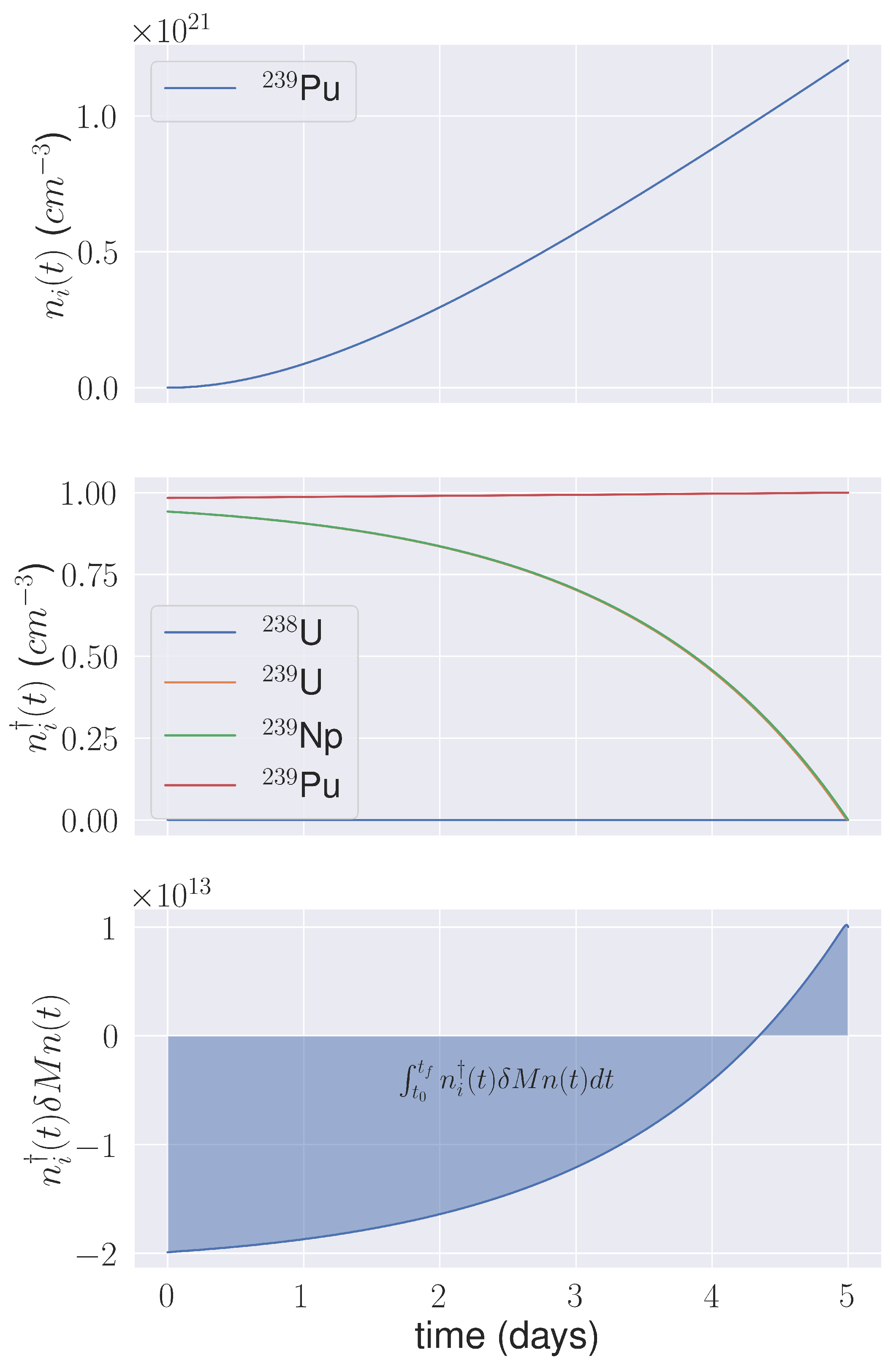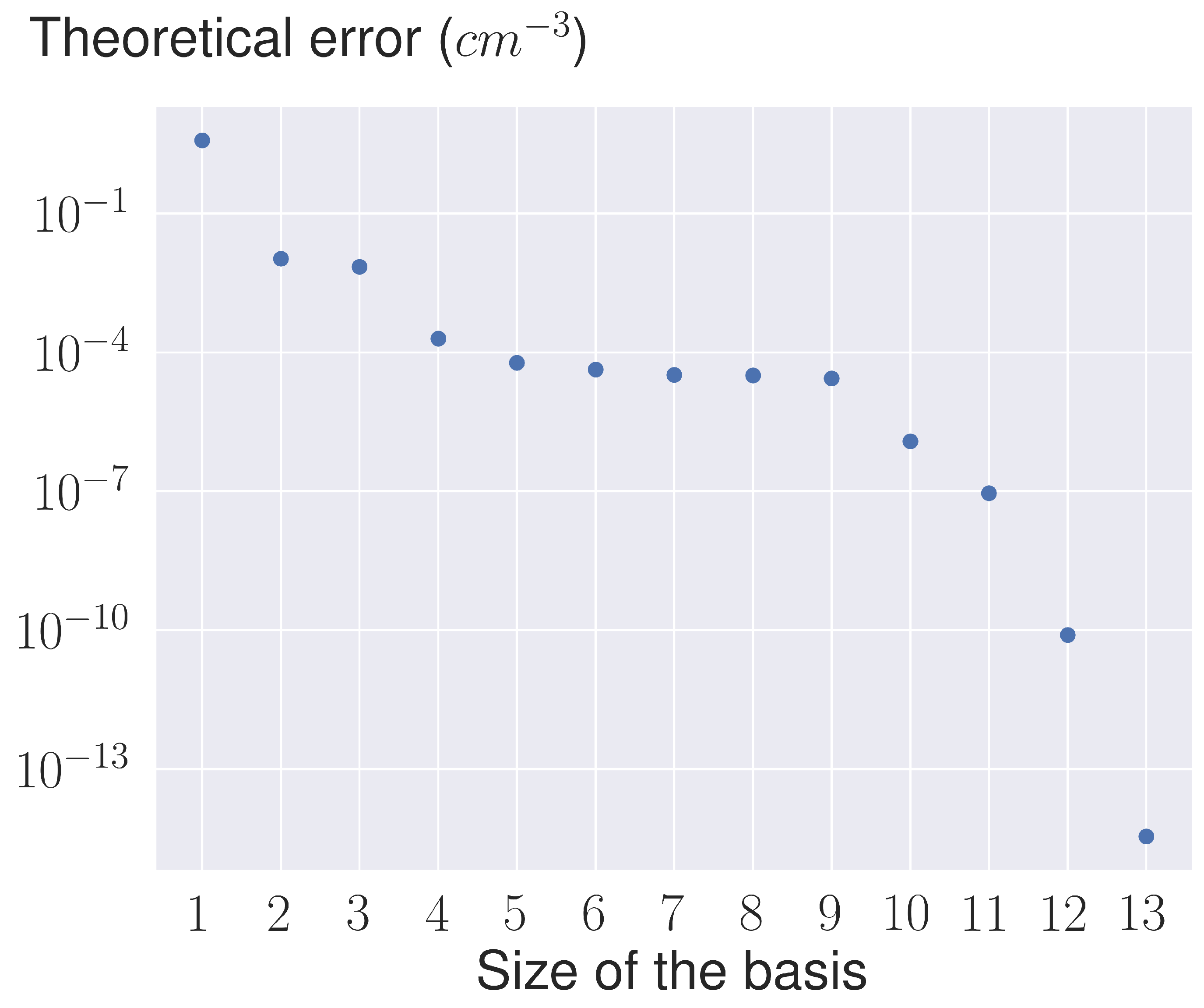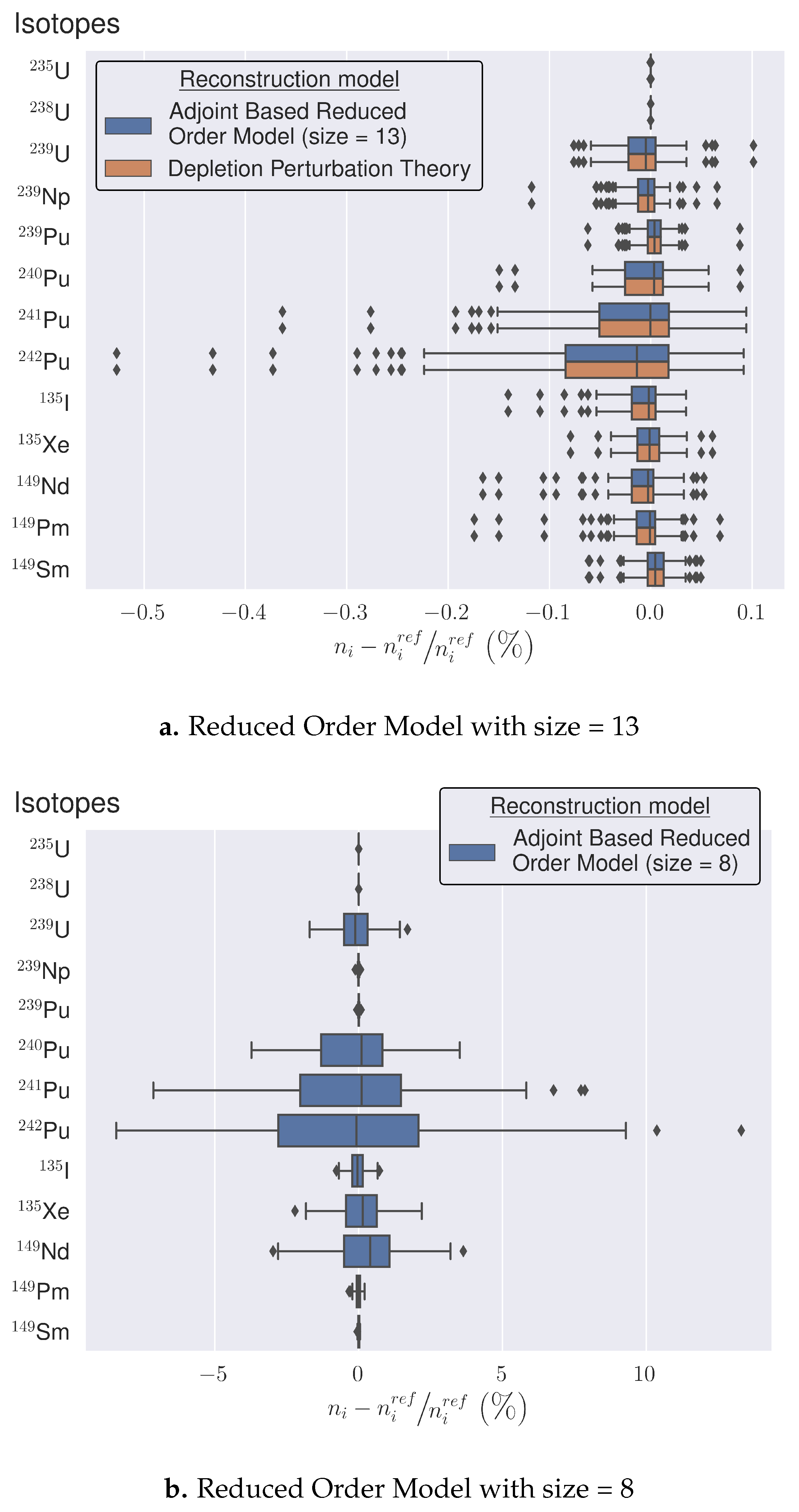1. Introduction
Nuclear power plants are a response to the production of low-carbon electricity and heat in the context of global warming. New reactor designs heavily rely on neutronics codes, which must be verified and validated. For example, one must ensure that these codes correctly evaluate the reactivity and power map of the cores throughout their entire cycle. Sensitivity and uncertainty studies can be used for the numerical validation step but they require repeated execution of time consuming neutron flux and depletion calculations. Hence, reducing the time required for these calculations can result in a significant reduction of the numerical validation studies’ cost.
Perturbation theories can be helpful in diminishing the coupled diffusion and depletion calculation time. Indeed, perturbation theories are approximated computational schemes that avoid a direct calculation to obtain the responses of a perturbed problem. Depletion Perturbation Theory [
1], Generalized Perturbation Theory [
2,
3] or Standard Perturbation Theory [
4] are widely used in reactor physics. Yet, they are restricted to single integral values perturbations, such as reaction rate ratios, reactivity or nuclide density.
Reduced basis methods are a response to this limitation. They allow the reconstruction of the full-power map or nuclide densities in a shorter time than solving the direct problem. They are usually divided into two steps, an offline step carried out once and an online step for each new calculation. In reactor physics, Proper Orthogonal Decomposition [
5,
6] or Principal Component Analysis in statistics [
7] are commonly used for the creation of the basis. The basis can be constructed using a range-finding algorithm which captures the active subspace of our problem and provides an a posteriori estimator for the precision [
8]. Modal expansion could also be used, but it has been proven faulty for interesting perturbed neutron flux reconstruction cases [
9]. Concerning the online step, most reduced order models are based on projections. For example, Galerkin projection allows solving a reduced order system instead of the full one [
10]. Differently, adjoint based reduced order model uses the adjoint equation to calculate the projection coefficients [
6]. Hence, one does not solve a reduced order system but simply calculates the projection of the solution on the reduced basis. Because of their computational performance, particularly for first-order formulation, adjoint based reduced order models are highly appealing for sensitivity and uncertainty studies. Furthermore, only one adjoint calculation per vector of the basis is needed rather than one adjoint calculation per isotope, as in Depletion Perturbation Theory.
In reactor physics, Exact-to-Precision Generalized Perturbation Theory has been developed for diffusion or transport calculations [
11]. This adjoint based reduced order model relies on a range-finding algorithm for the creation of the basis and Generalized Perturbation Theory for the calculation of the projection coefficients. For the depletion calculations, work has been done on reduced order modelling [
12] but no adjoint based reduced order model is readily available.
Therefore, this paper describes a novel adjoint based reduced order model for the Bateman equations. Our model uses the Depletion Perturbation Theory for the reconstruction of the nuclide densities and a range-finding algorithm to create the basis. This reduced order model takes advantage of the correlation between nuclide densities due to the transition matrices and the flux’s smooth spatial variation. Indeed, for Pressurized Water Reactors calculations, it is common to have few hundreds of thousands depleting media with up to 50 nuclides. As a proof of concept, this method is tested on an elementary example in
Section 4.
2. Materials and Methods
We can define the nuclide densities as
relevant to
I isotopes with
t the time. This field is then governed by the Bateman equation:
with
the burn-up and decay matrix:
The coefficients often have the following terms:
the decay constant of isotope i;
the absorption reaction rate of isotope i;
the fission reaction rate of isotope i;
the fraction of fission product j by the fission of isotope i (fission yield of fissile isotope i to fission product j).
Using the fact that the initial density is
and
is time independent, we have:
We can also define a perturbed configuration:
with and .
In this paper, we develop a reduced order model of the nuclide densities at the final time
:
The reduced basis of size R is obtained with a range-finding algorithm. It is the offline step. Then, the projection coefficients are calculated in the online step which is based on the Depletion Perturbation Theory. This reduced order model can be then called adjoint based. It can replace the depletion solver for sensitivity and uncertainty burn-up analysis. Since the reduced model works for a given final time, it imposes the use of constant time step during the depletion.
3. Theory
3.1. The Offline Step
The basis
is created during the offline step by using a range-finding algorithm. This algorithm constructs an active subspace of the nuclide densities. First, one has to calculate
R snapshots
with:
Each
is the results of the depletion Equation (
1) for a set of randomized input parameters
.
or
define the input parameters for the burn-up and decay matrix
. The randomization of the input parameters is done on the nuclear data and the neutron flux. These data are sampled according to a normal distribution with their nominal values as mean and a standard deviation given by the user.
Then, after the calculation of
R snapshots, we can factorize
using a compact singular value decomposition as:
Since , is a semi-unitary matrix, a square diagonal matrix and a semi-unitary matrix. is then the reduced basis for our reduced order model.
The precision of the basis
can be estimated using the a posteriori estimator derived in Ref. [
8]:
with
and
s the number of trials for the estimator. With
s trials, the following relation:
holds with probability of at least for every i.
The offline step is summarized in
Figure 1.
3.2. The Online Step
Once the basis
Q is created, the
coefficients have to be calculated. If the nuclide densities map is known at
, we have:
Hence, can be calculated with the Depletion Perturbation Theory.
Considering
, if we want to calculate
, we can use the method of Lagrange multipliers:
with the adjoint nuclide densities.
We have for every
i,
and
, hence:
By expanding
at first order, we have:
If we try to make
stationary to all the variables except
, we can derive two equations. The first one is the Bateman Equation (
1):
The second one is the adjoint Bateman equation:
By setting
, we have:
Enforcing the adjoint nuclides densities to fulfill the adjoint Bateman Equation (
16):
is the only term remaining in Equation (
15).
Thus, we have at first order:
Each projection coefficient can be evaluated independently. This allows a trivial parallelization of the online step.
To evaluate the integral term in Equation (
17), one can use a numerical integration algorithm like the trapezoidal rule. This algorithm requires the calculation of several values of
and
from 0 to
. These calculations are done once only in the offline step. It is worth noting that in decay heat calculation context, a robust time discretization is needed because of the short-lived nuclides [
13]. An example illustrating the calculation of
is available in
Figure 2. One can see that
is equal to 0 except for the
. This allows the calculation of
at
using the Depletion Perturbation Theory. Without perturbations in
,
is equal to the integral
in blue in
Figure 2.
On the contrary of Exact-to-Precision Generalized Perturbation Theory, we derive only a first order formulation. Indeed, for the exact variation, the coefficient values are:
and the term requires the knowledge of the perturbed densities for every t which cannot be linked to the first order formulation without approximation like in Exact-to-Precision Generalized Perturbation Theory.
4. Results and Discussion
In this section, we apply the adjoint based reduced order model described in
Section 3 to the simplified depletion chain of uranium, xenon and samarium with nuclear data using two energy groups. This numerical example is a proof of concept for our novel method. The description of the chains and the nuclear data values are available in
Appendix A. The results of the reduced order model are compared to the Depletion Perturbation Theory for each nuclide. The purpose of the reduced order model is the reconstruction of
n for a depletion with constant time steps of 5 days. For this numerical example, the vector
n has the following definition:
The Depletion Perturbation Theory results use one adjoint nuclide densities calculation for each isotope with the final values equals 0 except for the density of the isotope of interest which is equal to 1. The adjoint based reduced order model relies on the range-finding algorithm described in
Section 3.1. Since the dimension of
n is small for this simple problem, 13 snapshots are calculated and 10 trials are evaluated to estimate the precision. For each snapshot or trial, the nuclear data and the flux are sampled according to a normal distribution with their nominal values as mean and 1 % as their standard deviation. The a posteriori estimation of the basis’s precision is plotted in
Figure 3 as a function of the basis’s size. Results show that when the basis’s size tends towards the range of the depletion problem, the theoretical error
tends toward the machine precision.
One can see that even for this elementary case, the adjoint based reduced order model can diminish the number of adjoint densities calculations compared to the Depletion Perturbation Theory. Furthermore, the range-finding algorithm will likely be more efficient for real cases where it is common to have few hundreds of thousands depleting media with up to 50 nuclides.
Figure 4 presents the distribution of the reduced order model and Depletion Perturbation Theory errors
as box plot [
14] for 100 nuclear data and neutron flux random perturbations. The perturbed values are sampled according to a normal distribution with their nominal values as mean and 1 % as their standard deviation. Depletion Perturbation Theory errors are solely related to the first order approximation whereas the reduced order model errors depend on the reduced basis’s precision too.
Results show that the errors are identical for Depletion Perturbation Theory and the adjoint based reduced order model with a basis of size 13. When the size of the basis is 8, the errors increase for the isotopes with the lowest densities like .
The identical errors for Depletion Perturbation Theory and the adjoint based reduced order model suggest that with a basis reaching machine precision, both methods have the same precision. The fact that errors increase when the basis is smaller is consistent with the theoretical precision and is linked to the large range of nuclide densities:
for the
to
for the
. This could be an issue for isotopes with small densities and large cross sections like
. One way to take into account the importance of the isotope and not only its concentration is to weigh each nuclide density by its absorption cross section. This has been successfully applied in Ref. [
12] with weights equals to the absorption cross section of the isotope divided by the absorption cross section of
.
Overall, this serves as a proof of concept for our adjoint based reduced order model which can replace the depletion solver for sensitivity and uncertainty burn-up analysis.
5. Conclusions
Our results serve as a proof of concept for the novel adjoint based reduced order model presented in this paper. This reduced order model can readily replace the depletion solver to perform sensitivity and uncertainty studies in a shorter time.
Future work will focus on employing this methodology on real case applications like full Pressurized Water Reactors or Sodium-cooled Fast Reactors calculations.
Author Contributions
Conceptualization, T.S.; methodology, T.S.; software, T.S.; writing—original draft preparation, T.S.; writing—review and editing, P.A. and F.N.; supervision, P.A. and F.N.; project administration, P.A. and F.N. All authors have read and agreed to the published version of the manuscript.
Funding
This research received no external funding.
Data Availability Statement
Acknowledgments
The authors wish to thank Laurent Buiron and Jean Tommasi for helpful discussions of the manuscript.
Conflicts of Interest
The authors declare no conflicts of interest.
Appendix A. Description of the Depletion Chains
The depletion chains used in the proof of concept are given in
Figure A1,
Figure A2 and
Figure A3. They have been simplified to fit Pressurized Water Reactors needs. The nuclear data using two energy group are given in
Table A1. They are inspired by the one in the example two of Ref. [
1] and are not chosen to be particularly realistic. The definitions of the parameters are:
the absorption cross section of the group g;
the fission cross section of the group g;
the capture cross section of the group g;
the energy group g with the values 0 (fast neutrons) and 1 (thermal neutrons);
the initial concentration;
Y the fraction of fission products by the fission of all the isotopes (fission yield of all the isotopes);
the decay constant.
The neutron flux values are for the fast group and for the thermal one.
Table A1.
Nuclear data values for the numerical example, blank cells correspond to null values.
Table A1.
Nuclear data values for the numerical example, blank cells correspond to null values.
| Isotope |
(barn) |
(barn) |
(barn) |
(barn) |
(cm-3) |
Y |
(s-1) |
|
1.80 |
100.0 |
1.5 |
55.0 |
|
|
|
|
0.35 |
2.000 |
|
|
|
|
|
|
|
|
|
|
|
|
|
|
|
|
|
|
|
|
|
|
2.00 |
190.0 |
1.8 |
120.0 |
|
|
|
|
0.20 |
110.0 |
|
|
|
|
|
|
2.50 |
180.0 |
0.5 |
140.0 |
|
|
|
|
0.70 |
70.00 |
|
|
|
|
|
|
|
|
|
|
|
0.0640 |
|
|
|
|
|
|
|
0.0010 |
|
|
|
|
|
|
|
0.0109 |
|
|
|
|
|
|
|
|
|
|
|
|
|
|
|
|
|
Figure A1.
Simplified depletion chain of the .
Figure A1.
Simplified depletion chain of the .
Figure A2.
Depletion chain of the .
Figure A2.
Depletion chain of the .
Figure A3.
Simplified depletion chain of uranium.
Figure A3.
Simplified depletion chain of uranium.
References
- Williams, M.L. Perturbation and sensitivity theory for reactor burnup analysis. Technical report, Office of Scientific and Technical Information (OSTI), 1979. [CrossRef]
- Gandini, A. A generalized perturbation method for bi-linear functionals of the real and adjoint neutron fluxes. Journal of Nuclear Energy 1967, 21, 755–765. [Google Scholar] [CrossRef]
- Kiedrowski, B.C. Review of Early 21st-Century Monte Carlo Perturbation and Sensitivity Techniques for k-Eigenvalue Radiation Transport Calculations. Nuclear Science and Engineering 2017, 185, 426–444. [Google Scholar] [CrossRef]
- Usachev, L.N. Perturbation theory for the breeding factor, and other ratios of a number of different processes in a reactor. Soviet Atomic Energy 1963, 15, 1255–1265. [Google Scholar] [CrossRef]
- Buchan, A.G.; Pain, C.C.; Fang, F.; Navon, I.M. A POD reduced-order model for eigenvalue problems with application to reactor physics. International Journal for Numerical Methods in Engineering 2013, 95, 1011–1032. [Google Scholar] [CrossRef]
- Bang, Y.; Wang, C.; Abdel-Khalik, H.S. State-Based Adjoint Method for Reduced Order Modeling. Transport Theory and Statistical Physics 2012, 41, 101–132. [Google Scholar] [CrossRef]
- Jolliffe, I.T.; Cadima, J. Principal component analysis: A review and recent developments. Philosophical Transactions of the Royal Society A: Mathematical, Physical and Engineering Sciences 2016, 374, 20150202. [Google Scholar] [CrossRef] [PubMed]
- Halko, N.; Martinsson, P.G.; Tropp, J.A. Finding Structure with Randomness: Probabilistic Algorithms for Constructing Approximate Matrix Decompositions. SIAM Review 2011, 53, 217–288. [Google Scholar] [CrossRef]
- Sauzedde, T.; Archier, P.; Nguyen, F. Strengths and weaknesses of the modal expansion method for perturbations calculations in nuclear reactor physics. Annals of Nuclear Energy 2023, 193, 110024. [Google Scholar] [CrossRef]
- Cherezov, A.; Sanchez, R.; Joo, H.G. A reduced-basis element method for pin-by-pin reactor core calculations in diffusion and SP3 approximations. Annals of Nuclear Energy 2018, 116, 195–209. [Google Scholar] [CrossRef]
- Wang, C.; Abdel-Khalik, H.S. Exact-to-Precision Generalized Perturbation Theory for Eigenvalue Problems. Nuclear Engineering and Design 2013, 256, 130–140. [Google Scholar] [CrossRef]
- Castagna, C.; Aufiero, M.; Lorenzi, S.; Lomonaco, G.; Cammi, A. Development of a Reduced Order Model for Fuel Burnup Analysis. Energies 2020, 13, 890. [Google Scholar] [CrossRef]
- Linden, N.; Tsilanizara, A.; Tommasi, J. Depletion Perturbation Theory in decay heat calculation context. Annals of Nuclear Energy 2023, 185, 109743. [Google Scholar] [CrossRef]
- Krzywinski, M.; Altman, N. Visualizing samples with box plots. Nature Methods 2014, 11, 119–120. [Google Scholar] [CrossRef] [PubMed]
|
Disclaimer/Publisher’s Note: The statements, opinions and data contained in all publications are solely those of the individual author(s) and contributor(s) and not of MDPI and/or the editor(s). MDPI and/or the editor(s) disclaim responsibility for any injury to people or property resulting from any ideas, methods, instructions or products referred to in the content. |
© 2024 by the authors. Licensee MDPI, Basel, Switzerland. This article is an open access article distributed under the terms and conditions of the Creative Commons Attribution (CC BY) license (https://creativecommons.org/licenses/by/4.0/).
